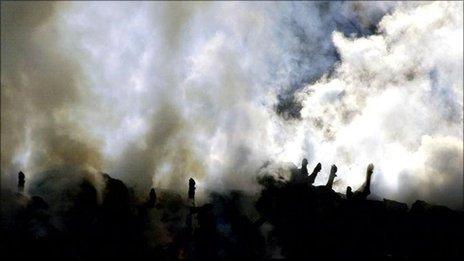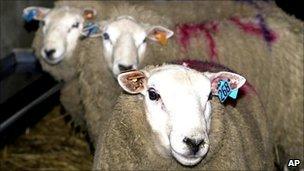Foot-and-mouth outbreak of 2001
- Published

Pyres of burning carcasses became a familiar sight in parts of the countryside
Foot-and-mouth was discovered at an Essex abattoir on 19 February 2001 and it quickly spread across the UK.
The highly infectious disease, which mainly affected cattle, pigs, sheep and goats, plunged the agricultural industry into its worst crisis for decades.
19 February
A routine inspection at Cheale Meats abattoir in Essex finds signs of foot-and-mouth disease in 27 pigs.
Samples are sent away for analysis. It is now believed that the virus had already spread to 57 farms nationwide in the days before the discovery.
Government contingency plans, drawn up in the wake of the 1967 epidemic, were based on an outbreak occurring in maximum of 10 farms.
It had already been superseded by events before the first case was even confirmed.
20 February
The Ministry of Agriculture, Fisheries and Food (Maff) confirms that the tests have proved positive.
The abattoir and two farms which supplied them have five-mile exclusion zones put around them. The disease is also found at a farm next door to Cheale Meats.
21 February
All exports of live animals, meat and dairy products are banned by the government, although the movement of animals within the UK continues.
The European Commission bans the import of live animals and animal products from the UK.
Northern Ireland blocks the import of animal and dairy products from the UK mainland.
22 February
A livestock market is held in Longtown Cumbria.

Thousands of sheep were culled during the outbreak
With export bans in place, there are more animals for sale on the domestic market than usual.
Undetected, some of them are carrying foot-and-mouth.
The UK livestock trade has changed markedly since the 1967 outbreak.
What was once a local trade has now gone national, meaning the disease is able to spread much more quickly, and much further afield.
23 February
The government introduces a ban on the movement of animals from affected areas.
24 February
The first mass slaughter, involving thousands of pigs and cattle, gets under way in farms across England.
2 March
Faced with overwhelming numbers of animals awaiting slaughter, the government calls in the army to help organise the cull.
An official report says troops should have been brought in much sooner.
The first outbreaks in Northern Ireland and Scotland take the number of cases to 40.
3 April
Prime Minister Tony Blair announces that the "feelings and sensitivities" of people in affected areas mean local elections and, it is assumed, the general election in England planned for 3 May must be delayed.
24 April
The human form of disease, which is not thought to be dangerous, is suspected in a slaughterman who came into close contact with infected animal material. It later proves a false alarm.
10 August
Calls for a full-scale public inquiry into the handling of the outbreak are ignored by ministers as three separate inquiries are announced.
19 August
The epidemic reaches the six-month mark with 3,750,222 animals slaughtered.
The tourist industry says businesses have lost trade estimated at £250m.
30 September
What becomes the last recorded case of the outbreak is found in animals in a field north of Little Asby, Appleby, Cumbria.
14 January 2002
With no outbreak for three months and negative tests on sheep flocks in Northumberland, the county where foot-and-mouth was initially traced, Britain declares itself free of foot-and-mouth from midnight.
International clearance and a resumption of trading status was expected to take longer, possibly months.